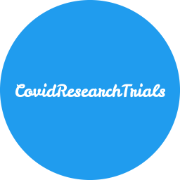 Covid 19 Research using Clinical Trials (Home Page)
Covid 19 Research using Clinical Trials (Home Page)
Report for D012893: Sleep Wake Disorders NIH
(Synonyms: Sleep Wa, Sleep Wak, Sleep Wake Disorders)
Developed by Shray Alag
Clinical Trial MeSH HPO Drug Gene SNP Protein Mutation
Correlated Drug Terms (3)
| Name (Synonyms) | Correlation | |
|---|---|---|
| drug1690 | Online cognitive behavioral therapy (CBT) Wiki | 0.71 |
| drug1689 | Online bibliotherapy programme Wiki | 0.71 |
| drug1613 | No intervention Wiki | 0.17 |
Correlated MeSH Terms (0)
| Name (Synonyms) | Correlation |
|---|
Correlated HPO Terms (0)
| Name (Synonyms) | Correlation |
|---|
There are 2 clinical trials
Clinical Trials
1 Efficacy of an Online Cognitive Behavioral Therapy (CBT) Programme Aiming at Reducing the Stress of Health Workers Involved in the Care of Patients During the Covid-19 Epidemic: a Randomized-controlled Trial
Some preliminary epidemiological research conduct in China in health workers involved in the care of Covid-19 patients has shown high rates of depression (>50%), generalized anxiety disorder (>44%), insomnia (>36%) and stress symptoms (>73%), which negatively impact their well-being as well as their ability to work effectively . These rates were observed during the epidemic peak, but they can also have a long-term mental health effect, both individually, but also in a systemic manner , similar to what has been reported relative to the SARS-CoV-1 . Cognitive behavioral therapy (CBT) is recognized as an effective treatment for stress-reduction, as well as for the prevention of multiple mental health problems in at-risk individuals . Moreover, CBT has been found to be effective in brief online formats , which could make it feasible during the current Covid-19 epidemic. To our knowledge, there are no online CBT programmes targeting stress problems in health workers involved in the care of patients during the current epidemic context. The aim of our study is to evaluate the efficacy of the online CBT programme we have developped to specifically address immediate perceived stress in health workers, as well as the prevention of mental health problems at 3- and 6-months follow-up
NCT04362358 Stress - Prevention of Sleep Disorders, PTSD and Depression Behavioral: Online cognitive behavioral therapy (CBT) Behavioral: Online bibliotherapy programme MeSH:Sleep Wake Disorders
Primary Outcomes
Measure: Significant score reduction at the Perceived Stress Scale Time: T0 inclusionMeasure: Significant score reduction at the Perceived Stress Scale Time: T1 (3-month follow-up)
Measure: Significant score reduction at the Perceived Stress Scale Time: T1 (up to 8 weeks treatment)
Measure: Significant score reduction at the Perceived Stress Scale Time: T2 (6-month follow-up)
2 COVID-19: Prospective Follow-up of Pulmonary Function, Sleep Disorders, Quality of Life and Post-traumatic Stress
The current project is a prospective, multicentric cohort study aiming at a multidisciplinary assessment (pulmonary, cardiometabolic, sleep and mental health) of the consequences of infection by SARS-CoV-2, 3 months after the diagnosis in order to better characterize these complications. 400 patients with a positive diagnosis of SARS-CoV-2 will be included in the study 3 months after their diagnosis: They will be followed at 6 months, 1 year, 3 years, and 5 years, as function of their after-effects discovered at 3 months and their evolution.
NCT04406324 COVID-19 Other: No intervention MeSH:Sleep Wake Disorders
Primary Outcomes
Description: Pulmonary function 3 months after COVID diagnosis, as measured by diffusion capacity of carbon monoxide (DLCO)
Measure: Diffusion Capacity for Carbon Monoxide (CO) 3 months after COVID diagnosis Time: 3 months after COVID diagnosisSecondary Outcomes
Description: Prevalence of Sleep Disordered Breathing, as measured by polysomnography
Measure: Prevalence of Sleep Disordered Breathing (SDB) 3 months after COVID diagnosis Time: 3 months after COVID diagnosisDescription: Prevalence of sleep disorders, as measured by polysomnography
Measure: Prevalence of sleep disorders 3 months after COVID diagnosis Time: 3 months after COVID diagnosisDescription: Prevalence of ventilatory impairments measured by pulmonary function tests
Measure: Prevalence of ventilatory muscle function impairments, 3 months after COVID diagnosis Time: 3 months after COVID diagnosisDescription: Prevalence of cardiac impairments measured by cardiac echography
Measure: Prevalence of cardiac impairments 3 months after COVID diagnosis Time: 3 months after COVID diagnosisDescription: Pulmonary function as measured by diffusion capacity of carbon monoxide (DLCO)
Measure: Follow-up of pulmonary diffusion capacity of carbon monoxide Time: From Baseline (3 months after COVID diagnosis) to 5 yearsDescription: Assessment of SDB treatments adherence will be monitored in hours/night
Measure: Follow-up of sleep disorders treatment compliance Time: From Baseline (3 months after COVID diagnosis) to 5 yearsDescription: Assessment of SDB treatments efficacy will be based on the residual AHI index (Apnea Hypopnea/hour) under treatment
Measure: Follow-up of sleep disorders treatments efficacy Time: From Baseline (3 months after COVID diagnosis) to 5 yearsDescription: HLA alleles will be assessed as a component of genetic immune capacity
Measure: HLA alleles aspect of COVID clinical presentation Time: 3 months after COVID diagnosisDescription: KIR loci will be assessed as a different component of genetic immune capacity
Measure: KIR loci aspect of COVID clinical presentation Time: 3 months after COVID diagnosisDescription: metabolome expression in sera
Measure: metabolomic aspect of COVID clinical presentation Time: 3 months after COVID diagnosis